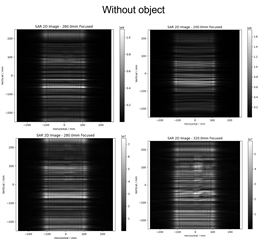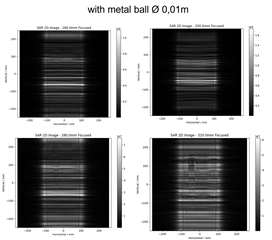Tool/software:
Hi there,
We would like to use the MMWCAS-RF EWM mounted on an MMWCAS-RF-DSP board in a SAR process to generate an image. For image reconstruction, a Range Migration Algorithm with phase compensation is used. The radar board is mounted in a tunnel, which is lined with absorbent mats on the inside to reduce environmental scatter. The following pictures schematically show the setup we used.

The radar board is 0.26 meters away from the target object. The object moves relative to the radar board at a speed of 0.1 m/s on a conveyor belt, perpendicular to the azimuth alignment of the board. The "Inter_Frame_Interval" has been set to 0.01 s in the LUA script. Other parameters used are Start_freq = 77 GHz, Slope = 70.295 MHz, idle_time = 7 us, adc_start_time = 4 us, adc_samples = 256, sample_freq = 5020 ksps, ramp_end_time = 55, rx_gain = 30, start_chirp_tx = 0, end_chirp_tx = 11, nchirp_loops = 4, n_frames = 250.
For evaluation, the first block from each frame is used so that the measurement point intervals are equidistant, each being 0.001 m. The virtual antennas are equidistant with lambda/4.
The following images were generated at different distances for focusing the target object.





Do you have any idea why we observe a form of aliasing in the vertical direction, both with and without the object? For calibration, we use the same computational procedures as those found in C:\ti\mmwave_studio_02_01_01_00\mmWaveStudio\MatlabExamples. Could a re-recording of data for calibration improve the result?
I found another script online. The authors also used a matrice called “delay offset” for every virtual channel they used to calibrate the beat frequency offset. Is there any Example how to obtain these offset times?
Kind regards,
Robin

